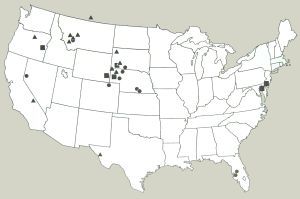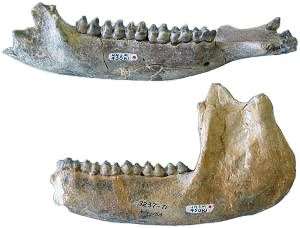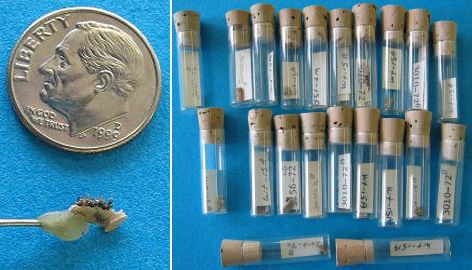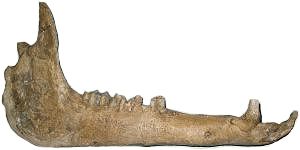
Nebraska County Fossils
Webster
< Vertebrate Paleontology Home
A virtual journey through the Museum's vertebrate paleontology collection.
Tapiravus polkensis, Polk's Tapir
Family: Tapiridae
Geologic age: Miocene (Late Barstovian), about 13.5 million years old
Year fossil collected: 1971


Tapirs are quite rare in the fossil record. Localities in the United States that produce pre-Ice Age fossil tapirs are shown at the left. You can see that Nebraska's fossil record is extremely important for this group of "jungle" animals. Living tapirs can be found today only in South America and Southeast Asia. They became extinct in North America 11,000 years ago.
Antrozous, Lasiurus, Myotis, Bats
Family: Vespertilionidae
Geologic age: Miocene (Late Barstovian), about 13.5 million years old
Year fossil collected: 1972

Pressed for space? A whole collection of fossil bat jaws can fit in the palm of your hand! Bats are among the smallest (and rarest) of fossil mammals. Collecting these "microfossils" is tedious work, requiring hours of washing, sorting and picking sediment. Notice that the entire tooth row in the jaw below is about as long as the date on this dime!
Titanotylopus nebraskensis, Titanic Nebraska camel
Family: Camelidae
Geologic age: Pleistocene, about 1 million years old
Year fossil collected: 1933


Nebraska's "titanic camel" towered over the other Plains creatures of the day. It stood about 9 feet tall at the shoulder, and could stretch to browse on tender leaves perhaps 15 feet up into the trees! This gave Titanotylopus a great advantage over other animals in its competition for food. Shane Tucker holds this trophy jaw nearly 3 feet long!
Geological Ages of Rock Formations

| Q | Pleistocene ("Ice Age") Sands, gravels, silts overlay much of the county (not shown) Pleistocene sands, gravels and silts overlay much of Nebraska and often conceal the bedrock beneath. These "Ice Age" deposits often produce the remains of mammoths, bison, horses, musk oxen, elk and other familiar mammals. Small fossils, especially, are important indicators of the climate at the time of deposition. |
| Tpo | Tertiary, Miocene/Pliocene, Ogallala Group, 2-14 million years old Ogallala Group rocks include predominantly clastic sands and sandstones composed of a mixture of Rocky Mountain debris and locally derived and re-worked sediments. Ash beds are not unusual in the Ogallala and help to precisely date the sediments. In western and southwestern Nebraska, the Ogallala beds are responsible for resistant bluffs that cap the valley sides of modern streams. |
| Kn | Cretaceous, Niobrara Formation, 80-88 million years old The Niobrara Formation is composed predominantly of grey to yellow chalk and chalky shale. It is well exposed along the southern and northeastern borders of Nebraska, although outcrops are generally limited to vertical cliffs. In Nebraska, this unit produces the same fauna as found in the well developed badlands of western Kansas. Fossils include large fish, mosasaurs and pterosaurs, but due to limited exposures, fossils are found less frequently than in Kansas. |
| Kc | Cretaceous, Carlisle Formation, 88-92 million years old The Cretaceous Carlisle Shale is composed of a series of dark green to olive sediments ranging from chalk to shale to sandstone, indicating a shallowing of the sea that once covered mid-America. Several transgressions (change in sea level/position of shorelines) took place during the Cretaceous. |





